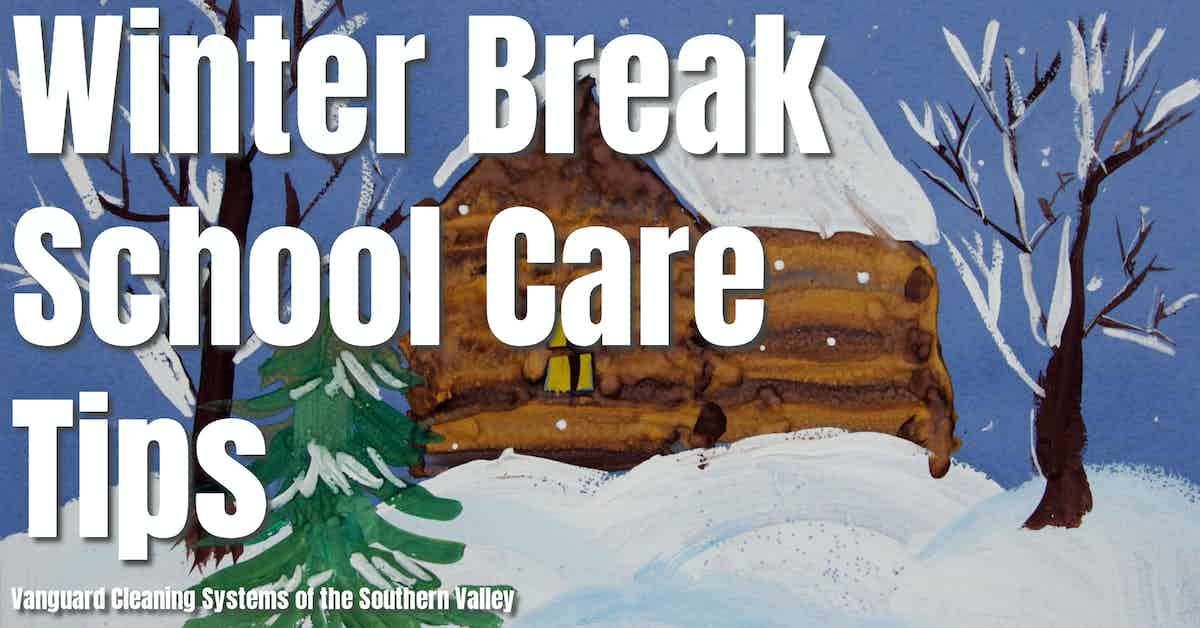Winter break allows facilities managers and custodial workers to deep clean, sanitize, and perform planned maintenance on classrooms and education facilities.

Promoting Cleaner School Environments
Cleaner classrooms promote better health and safety, resulting in optimal learning conditions associated with improved test scores, attendance, and behavior.
According to the National Center on Safe Supportive Learning Environments:
An extensive amount of research investigates how positive school environments can impact academic outcomes, student attendance, and graduation rates.
Academic achievement can be influenced by a combination of factors related to the physical space and quality of schools as well as students and staffs’ emotional well-being.
Conversely;
[...] studies show that indicators of the poor school environment are strongly linked to poor test scores, low graduation rates, low attendance rates, and student disengagement.
For example, some evidence shows that teacher burnout is associated with worse academic achievement and lowered student motivation.Indicators of a poor school environment include low levels of teacher satisfaction, high rates of teacher turnover, low academic expectations, and a messy or unsafe physical place.
However, when cleaning, it is critical to properly assess what chemicals are appropriate and safe for use in the classroom.
Many products emit toxins known as volatile organic compounds that are especially harmful to school-aged children--commonly leading to respiratory issues (asthma), learning challenges, increasing absences, and behavioral issues.
As the American Lung Association points out, some cleaning supplies have dangerous chemicals, such as VOCs (volatile organic compounds) that can contribute to chronic respiratory troubles, allergic reactions and headaches.
Some cleaning chemicals are known to be cancerous and can produce dangerous indoor pollutants. In other words, you could be cleaning a school, every day, and your students could still wind up sick.
TackLing Tough Winter Custodial Tasks
Winter break cleaning should be divided into two primary categories--floor care and high-traffic area cleaning and sanitization.
To get the most bang for your buck during the short two-week period, focus on primary entry routes.
Soil and bacteria are most commonly introduced to facilities on the bottoms of occupant shoes.
According to a recent survey, over 98% of bacteria on the bathroom floor got there because it was tracked in from the outside.
The rest comes from toilets spraying while flushing and people missing the bowl.
If you go for a daily walk, retrace your steps in your mind and think of all the possible scenarios where the soles of shoes can pick up bacteria. This includes scenarios such as:
Someone not cleaning up after their dog
Bird fecal matter
Spit
Urine
Blood
Someone wearing shoes inside a dirty house, then transferring it to a spot where your shoes picked it up again.
Floors of public restrooms
To tackle tough floorcare challenges, sweep, mop, vacuum, strip, wax, and shampoo the floors in the main office and main entry points in classrooms.
Additionally, this is the perfect time to service the walkway and entry mats.
Once the floor care routine is complete, you'll want to go back through and decontaminate high-traffic areas and germ hotspots.
In general, start with a deep clean using a commercial-grade detergent.
Depending on the surface type, several technologies can significantly improve cleaning outcomes, such as scrubber-vacs.
Once the surface has been thoroughly cleaned, apply a disinfectant appropriate for the germs your facility is combatting.
In the U.S., during the winter months, that's going to include influenza, norovirus, COVID, and RSV.
Next of importance for cleaning before applying disinfectant is to ensure the product is applied uniformly and allowed to sit and remain damp for the recommended dwell period.
Interrupting the process before the dwell period has expired will reduce the efficacy of the disinfectant and likely present several health and safety issues.
This process can be significantly improved by spraying with an electrostatic sanitization appliance.
According to a 2019 Florida School study;
Following its own two-year study, Flagler School in Bunnell, Florida has concluded that daily sanitization of the school using an electrostatic sprayer reduced absenteeism by 14 percent during the 2019 school year.
Data from the 2019 school year was compared against the previous year.
For the duration of the 2017-2018 school year the district used the electrostatic cleaner once a month and conducted manual cleaning each day.
During the 2018-2019 school year, Flagler used electrostatic technology daily in one of its elementary schools, and stuck to its old method in another. Those two schools were then compared against the absenteeism rates for 2018.
The school that received daily treatment from the electrostatic technology reported the 14 percent reduction in absenteeism and no outbreaks of illness.
The other school saw a decline in absenteeism, though it was less significant.
Takeaway
Clean schools result in superior educational outcomes, and winter time provides an ideal window for deep cleaning and sanitizing challenging facility areas--specifically entry points, high-traffic areas, and flooring.
Onboarding and managing the requisite labor and material resources necessary to ensure the highest standards of cleanliness are achieved and maintained may prove cost-prohibitive for many organizations.
Outsourcing is a proven method for onboarding highly in-demand cleaning and sanitization services and experience for a fraction of the price of maintaining a similar service in-house.
If you would like more information regarding the effectiveness of high-performance infection prevention and control measures, or if you would like to schedule a free, no-obligation on-site assessment of your facility's custodial needs, contact us today for a free quote!
In Bakersfield, CA, call (661) 437-3253
In Fresno, CA, call (559) 206-1059
In Valencia, CA, or Santa Clarita, CA, call (661) 437-3253
In Palmdale, CA, or Lancaster, CA, call (661) 371-4756

